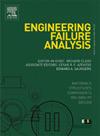Hydrogen charging-induced corrosion behavior evolution of an additive-manufactured austenitic stainless steel in sulfuric acid medium
IF 4.4
2区 工程技术
Q1 ENGINEERING, MECHANICAL
引用次数: 0
Abstract
The corrosion behavior of additive-manufactured UNS S21900 steel in 0.5 M H2SO4 was studied after hydrogen charging. The results indicated the decreased corrosion resistance after hydrogen charging. Passive current density increased from 2.95 × 10-6 to 2.01 × 10-5 A·cm−2 after 12 h, accompanied by inductive behavior. Mott-Schottky analyses showed increased acceptor density (2.67 × 1022 to 5.83 × 1022 cm−3) and donor density (1.91 × 1021 to 2.74 × 1021 cm−3) after charging for 12 h. The O2–/OH– ratio dropped from 2.25 to 0.05 after 12 h charging, indicating reduced compactness and protection due to the increased presence of metal hydroxides.
添加剂制备的奥氏体不锈钢在硫酸介质中充氢致腐蚀行为演变
研究了增材制造的UNS S21900钢加氢后在0.5 M H2SO4中的腐蚀行为。结果表明,充氢后合金的耐蚀性降低。12 h后,无源电流密度由2.95 × 10-6增加到2.01 × 10-5 A·cm−2,并伴有感应行为。Mott-Schottky分析表明,充电12 h后,受体密度(2.67 × 1022至5.83 × 1022 cm−3)和供体密度(1.91 × 1021至2.74 × 1021 cm−3)增加。充电12 h后,O2 - /OH -比值从2.25下降到0.05,表明由于金属氢氧化物的存在,致密性和保护作用降低。
本文章由计算机程序翻译,如有差异,请以英文原文为准。
求助全文
约1分钟内获得全文
求助全文
来源期刊

Engineering Failure Analysis
工程技术-材料科学:表征与测试
CiteScore
7.70
自引率
20.00%
发文量
956
审稿时长
47 days
期刊介绍:
Engineering Failure Analysis publishes research papers describing the analysis of engineering failures and related studies.
Papers relating to the structure, properties and behaviour of engineering materials are encouraged, particularly those which also involve the detailed application of materials parameters to problems in engineering structures, components and design. In addition to the area of materials engineering, the interacting fields of mechanical, manufacturing, aeronautical, civil, chemical, corrosion and design engineering are considered relevant. Activity should be directed at analysing engineering failures and carrying out research to help reduce the incidences of failures and to extend the operating horizons of engineering materials.
Emphasis is placed on the mechanical properties of materials and their behaviour when influenced by structure, process and environment. Metallic, polymeric, ceramic and natural materials are all included and the application of these materials to real engineering situations should be emphasised. The use of a case-study based approach is also encouraged.
Engineering Failure Analysis provides essential reference material and critical feedback into the design process thereby contributing to the prevention of engineering failures in the future. All submissions will be subject to peer review from leading experts in the field.
 求助内容:
求助内容: 应助结果提醒方式:
应助结果提醒方式:


